@Flynn4Matt[/author_info] [/author]
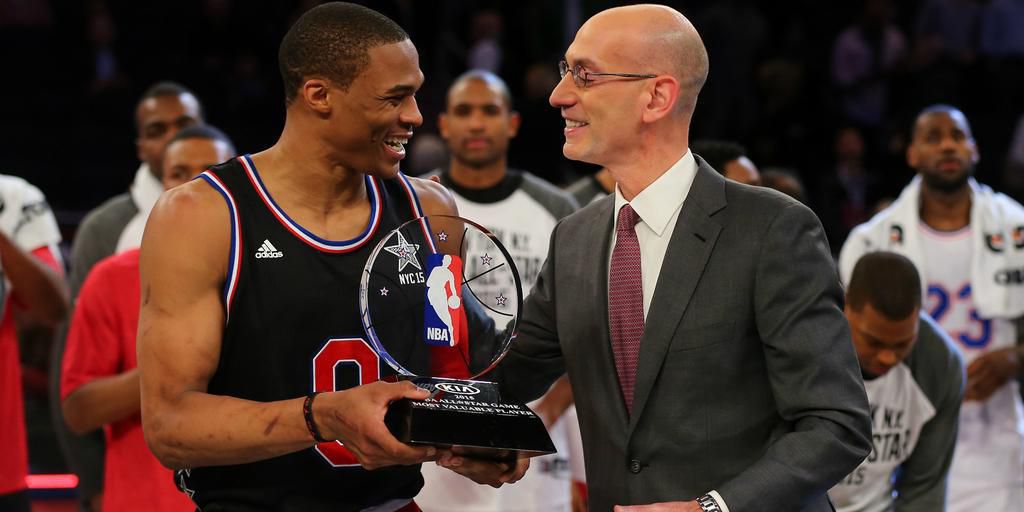
Count down the days, as the NBA season sets for a massive tip-off week starting on Tuesday, October 27th in glorious fashion.
The game has changed quite a bit just in this fresh decade, with teams focusing more than ever on athleticism and speed, evident in two distinct changes. The first: an emphasis on picking ‘project’ players with later draft picks (AKA young kids with high athletic ceilings and quick feet), and the second: a complete overhaul of the point guard position.
The point guard position was always more about sharing the basketball – the guy most willing to set plays up for his teammates. But, in today’s game, the position is dominated by athletic, score-first players who use their quickness to exploit match-up problems.
Chris Paul, perhaps one of the last subscribers of the old philosophy, said it best:
“There’s only one position I’ve ever had to play, and that’s Point Guard. So, I’ve always had to be that leader, and that was my job: you know, to talk,” said Paul in a 2012 interview.
This column will explore the top 10 players at the point guard position currently in the NBA, discovering how many of them subscribe to the pass-first style, or how many are committed to their own scoring and athleticism. Is it better to be John Stockton or Jason Kidd, or is it better to be Allen Iverson or Oscar Robertson?
The Honorable Mentions (in alphabetical order):
Goran Dragic (Miami Heat), Ty Lawson (Houston Rockets), Jeff Teague (Atlanta Hawks)
Dragic, a mid-season acquisition for the Heat last year was selected to an All-NBA 3rd team spot in 2013 and figures to be a large part of a rebound for Miami after missing the playoffs last season. Dragic is efficient, 50% from the field last season, and can play either guard position.
Lawson was picked up by the Rockets in the offseason, a team that managed to get all the way to the conference finals despite a myriad of injuries before being ousted by the Golden State Warriors. Lawson replaces Patrick Beverley in the starting lineup, hoping to take some ball-handling pressure off of MVP candidate James Harden, and establish more of a pecking order offensively. Lawson’s biggest skill is his passing, finishing 3rd in assists per game twice in his career.
Teague was selected to his first all-star game last year, and was a large portion of a wonderful regular season by the Hawks, en route to a #1 seed for the conference playoffs. Teague has quick hands and is a sturdy defender, looking to build upon last season’s success of 16 points-7 assists-2 steals per game and a career high 20.6 player efficiency rating, the league average is 15.0.
Stat Key: PPG-Points Per Game, APG-Assists Per Game, RPG-Rebounds Per Game, SPG-Steals Per Game, BPG-Blocks Per Game, Field Goal Percentage/3-Point Percentage/Free Throw Percentage, PER-Player Efficiency Rating (average is 15.0), WS-Win Shares (Amount of Team’s Wins Player is Statistically Responsible For), BPM-Box Plus/Minus (A Metric Measuring Value Added to Team Per 100 Possessions)
#10. Mike Conley (Memphis Grizzles), Height: 6-1, Experience: 8 Seasons
| 15.8PPG | 5.4APG | 3.0RPG | 1.3SPG | 0.2BPG | 45/39/86 | 18.6PER | 6.8WS | 2.7BPM |
Accolades: 1x Selection to All-NBA 2nd Defensive Team
-The Grizzlies long-term point guard is a frisky defender, using his quickness and aggressive nature to be a tough one-on-one matchup for even the most athletic point guards opposite him. Conley went through a long period of time where he was substantially underrated, because a ton of what he brings to the table aren’t quantifiable in straight statistics, but even when basing determinations on stats, his 3-point percentage has skyrocketed up to almost 40%, and had a decent 16 points per game despite battling injuries last season.
Scout Quote: “That’s quintessential Mike, making the play, being aggressive, but also not losing his composure. On a team of guys who are emotional, like Tony (Allen) and Zach (Randolph) and even Marc (Gasol), he’s a steadying influence. People lean on him because he’s going to keep his head in the game. He’s focused. He’s never going to get too high or too low. And I think over time, people started deferring to him more and more, especially after Rudy (Gay) left,” Jason Levien, Grizzlies’ CEO said.
#9. Tony Parker (San Antonio Spurs), Height: 6-2, Experience: 14 Seasons
| 14.4PPG | 4.9APG | 1.9RPG | 0.6SPG | 0.0BPG | 49/43/78 | 15.9PER | 4.1WS | -2.0BPM |
Accolades: 1x NBA Finals MVP, 6x All-Star, 4x NBA Champion, 3x Selection to All-NBA 2nd Team, 1x Selection to All-NBA 3rd Team, 1x Top 3 Finish in FG% (3rd).
-Though now in the twilight of his career, the oft-injured Parker battled hamstring injuries all during last season, seeing him post statistics well below that of his normal averages. Despite all of this, Parker loves to operate in the middle of the floor, he’s a deadly efficient shooter, and has even expanded his range out to the 3-point line, posting a wonderful 43% last season. His signature floater in traffic and jump-shooting off of picks make him a dangerous offensive weapon, but now slowed with injuries, Parker’s defense has begun to suffer. He’s wildly experienced, smart with the basketball, and has anchored four San Antonio championship seasons.
Scout Quote: “The Spurs thrive when Parker is aggressively finishing at the rim, pushing the ball in transition and kicking it out to the wings for long-range opportunities. Before a subpar 2014-15 season, when he was significantly affected by a left hamstring strain suffered in December, Parker had made three consecutive All-Star appearances,” Michael Wright, ESPN.
#8. Derrick Rose (Chicago Bulls), Height: 6-3, Experience: 6 Seasons
| 17.7PPG | 4.9APG | 3.2RPG | 0.7SPG | 0.3BPG | 41/28/81 | 15.9PER | 1.2WS | -1.3BPM |
Accolades: 1x NBA MVP, 3x All-Star, 1x R.O.Y., 1x Selection to All-NBA 1st Team, 1x Top 5 Finish in Win Shares (5th), 1x Top 5 Finish in BPM (4th)
-Rose has been an interesting story the last few years, a roller-coaster of bad attitude and injuries that had many questioning the former MVP’s place on the Bulls. Rose missed all of 2012, played only a handful of games in 2013, and spent a ton of time injured last season in 2014 with meniscus and hamstring injuries. Although he showed improvement and a desire to get on the court, last year’s numbers are nowhere near that of his MVP season, yet, we did see his numbers begin to have an uptick come end-of-the-season/playoff time. An orbital fracture in his face may keep him out at the beginning of the year, but he’s worth putting in the Top 10 based on upside alone, the man can score the basketball.
Scout Quote: “To watch Rose at the end of last season was to see the return of the assassin we knew before the breakdowns of both body and communication, the misunderstandings, the hubris, and the tragic, before all of the bad luck and bad timing,” Tim Baffde, Sports Illustrated.
#7. Kyle Lowry (Toronto Raptors), Height: 6-0, Experience: 9 Seasons
| 17.8PPG | 6.8APG | 4.7RPG | 1.6SPG | 0.2BPG | 41/34/81 | 19.3PER | 7.1WS | 3.6BPM |
Accolades: 1x All-Star
-Lowry comes into this season with a well-documented weight loss and a hope to make the jump from good player to great player after a couple of all-star caliber seasons with Toronto. He and DeMar DeRozan make up a dangerous backcourt, and Lowry is an intricate part of what makes Toronto one of the best teams in the East. His Box Plus-Minus proves his added value to the team, and Lowry reminds one of a pit-bull with his uncanny ability to rebound the basketball for a guard. He’s also a decent defender, though occasionally a little slow, and a good three point shooter, but often takes too many shots to be very efficient.
Scout: “He will be turning 30 near the end of this season and likely will slowly, but surely, regress physically unless he continues to stay in the impressive shape that he has attained over the course of this offseason. He is primed to take another step towards superstardom, and not a moment too soon, as the Raptors look to do the same in the playoffs,” Ryan Greco, Fansided.
#6. John Wall (Washington Wizards), Height: 6-4, Experience: 5 Seasons
| 17.6PPG | 10.0APG | 4.6RPG | 1.7SPG | 0.6BPG | 46/30/79 | 19.9PER | 7.8WS | 3.5BPM |
Accolades: 2x All-Star, 1x Selection to All-NBA Defensive 2nd Team, 2x Top 3 Finish in APG (2nd, 2nd)
-John Wall is arguably the fastest player in the league, using his length and agility to be a graceful defender, good engineer of fast break points, and also grab rebounds with the best of the guard position. His assists, and passing ability, are perhaps second in the NBA behind Chris Paul, as he has consistently placed well in assist marks, what’s missing from him being great; however, is a true scoring touch that goes beyond that of his athletic ability. He’s a really good floor general, but lacks the ability to take over the game with his own offensive ability, so he’s clearly more of a Tier Two guard rather than a Tier One.
Scout: “Point guard John Wall is a player a team can build around and has become one of the best passers in the NBA. His ability to hit a guy for the open corner three is, well, wizardly (sorry). But Wall can’t do it all by himself. He averaged 17.6 points, 10 assists and 4.6 rebounds per game last season, becoming the all-around point guard Washington thought he’d be when he was drafted first overall,” Kyle Ratke, NBA.com
#5. Kyrie Irving (Cleveland Cavaliers), Height: 6-3, Experience: 4 Seasons
| 21.7PPG | 5.2APG | 3.2RPG | 1.5SPG | 0.3BPG | 47/42/86 | 21.5PER | 10.4WS | 3.3BPM |
Accolades: 3x All-Star, 1x R.O.Y., 1x Selection to All-NBA 3rd Team
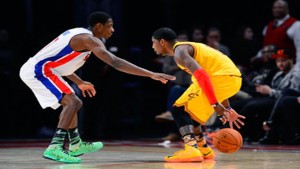
-Irving came onto the scene in a hurry with these ‘Uncle Drew’ television ads showcasing his unrivaled ability to dribble the basketball, but although Irving’s one-on-one takes to break his defender down are his best attribute, in reality, Irving also benefits from a smooth jump-shot and soft touch around the basket. As a pure scorer, Irving is as good as any point guard, often deferring the play-calling duties to one LeBron James, but with decent assist numbers, growing defensive intensity, and really strong efficiency in his top tier scoring statistics, Irving cracks our Top Five. Truthfully, his only drawback is the fact that he spends chunks of time injured with non-serious, but often nagging, injuries.
Scout: “LeBron James once called Kyrie Irving the best below-the-rim finisher in NBA history. That’s quite a compliment for a player who is just entering his fifth season, but he’s more than earned it. The Cavaliers’ three-time All-Star point guard has stockpiled highlights of razzle-dazzle, circus-type layups over the outstretched arms of big men during his 256 career games. But in the midst of finishing acrobatic layups and the hard contact that comes with it, Irving’s body has taken a toll,” Chris Haynes, Cleveland.com
#4. Damian Lillard (Portland Trail-Blazers), Height: 6-3, Experience: 3 Seasons
| 21.0PPG | 6.2APG | 4.6RPG | 1.2SPG | 0.3BPG | 43/34/86 | 20.7PER | 10.6WS | 5.1BPM |
Accolades: 2x All-Star, 1x R.O.Y., 1x Selection to All-NBA 3rd Team
-Damian Lillard, the wiz-kid from the 2012 draft, has been a brilliant steal for Portland and now, with LaMarcus Aldridge departed for San Antonio, will finally take over the mantle as the Franchise’s best player. While players like Kyrie Irving (LeBron), Mike Conley (Gasol and Randolph), and to some extent, Kyle Lowry (DeRozan), Derrick Rose (Butler and Gasol), and Tony Parker (Leonard and Duncan) don’t have to worry about carrying the full weight of a franchise as their best player, Lillard clearly does. His points per game already sit over 20, which is fourth for point guards, they expect to take another tick up with the massive departures for Portland in free agency. His passing instincts aren’t quite there yet, nor is his defense, but he knows how to be a leader and score the basketball, and now, everything is up to him.
Scout: “At 25 years old — or young, depending on how you look at it — Lillard now carries the hopes of an entire franchise on his shoulders. LaMarcus Aldridge is gone, chasing a world title in San Antonio. Wes Matthews is gone, reunited in Dallas with Deron Williams and Jeremy Evans from his Utah Jazz days. Nic Batum is gone, now a small forward in Charlotte. Robin Lopez is gone, a free agent centerpiece with the New York Knicks. If you’re counting, that’s four of five starters from the reigning Northwest Division champions. The rubble is clear, and Lillard is the only mainstay remaining. He’s the one being counted on to guide a bunch of young and unproven players, a gaggle of free agent signings and draft picks looking to make their mark,” Rick Egan, the Salt Lake Tribune.
#3. Stephen Curry (Golden State Warriors), Height: 6-3, Experience: 6 Seasons
| 23.8PPG | 7.7APG | 4.3RPG | 2.0SPG | 0.2BPG | 49/44/91 | 28.0PER | 15.7WS | 9.9BPM |
Accolades: 1x NBA Champion, 1x NBA MVP, 1x Selection to All-NBA 1st Team, 1x Selection to All-NBA 2nd Team, 4x Top 3 in 3P% (3rd, 3rd, 3rd, 3rd), 2x Leader in FT%, 1x Top 5 in PER (3rd), 2x Top 5 in WS(3rd,4th), 2x Top 5 in BPM (2nd,5th)
-Chef Curry is the best volume shooter in the NBA. He’s good in traffic, the best in the business at the
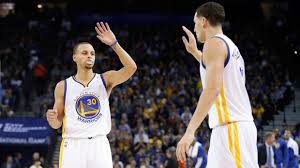
Free Throw line, a deadly long-range shooter, and pretty gifted in the paint too. His defense, although not great yet, has improved in the team system by Steve Kerr, and because of the great team system, Curry’s win shares are a bit bloated. Solid efficiency and good passing statistics accompany Curry as well, but it’s his ability to get impossibly hot shooting the basketball that separates him and makes him a Tier 1 Point Guard. The other two players ahead of him are just a bit more consistent, as Curry does have games where, without his shot, his game really suffers. Bouts of inconsistency make him 3rd, while popular opinion would have him higher than third on the list.
Scouts: “Steph plays like he’s a wide receiver in football running an option route on every play. Everything he does depends on what the defender is doing. So when he’s coming at you, if you’re afraid of the three — which you should be — and you give him too much space, he’ll knock it down. If you play too far up on the three, he’ll take you off the dribble. If he beats you on the first step because you were playing too far up, say goodbye. He’s already gone. If you sink back with him, he has the shiftiness and the quick release to step back and shoot,” Isaiah Thomas, Celtics Guard.
#2. Chris Paul (Los Angeles Clippers), Height: 6-0, Experience: 10 Seasons
| 19.1PPG | 10.2APG | 4.6RPG | 1.9SPG | 0.2BPG | 49/40/90 | 26.0PER | 16.1WS | 7.5BPM |
Accolades: 8x All-Star, 1x R.O.Y., 4x Selection to All-NBA 1st Team, 2x Selection to All-NBA 2nd Team, 1x Selection to All-NBA 3rd Team, 5x Selection to All-NBA Defensive 1st Team, 2x Selection to All-NBA Defensive 2nd Team, 7x Top 3 in APG (1st,1st,1st,1st,2nd,2nd,3rd), 6x Leader in SPG, 5x Top 5 in PER (2nd,2nd,3rd,3rd,5th), 6x Top 5 in WS (1st,2nd,2nd,2nd,3rd,4th), 7x Top 5 in BPM (2nd,2nd,2nd,2nd,3rd,4th,4th)
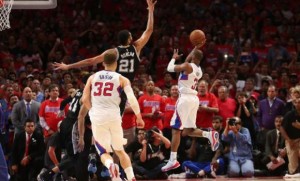
-When you talk of 21st Century Point Guards, you talk of Chris Paul, he now has a 100% chance to be a Hall-of-Famer according to Basketball-Reference. Just by looking at his accolades and statistics, many things become clear: first is that he is an ‘other-worldly’ passer, strong leader, and the very definition of a floor general, second is that he’s wonderfully efficient and has improved his jump-shot every single year in the league, and thirdly, that he’s one of the very best on-ball defenders in the league. The argument against Paul is always the same, which is that he’s never won in big moments, and although his playoff statistics do not indicate it, eye-test shows that Paul has made some BIG mistakes in critical games. He’s also won series’ by himself (last year in San Antonio) as well. His three-point shooting is becoming a strong attribute after not having it to start his career, mainly because his advancing age and height limitations make it hard for him to get by a defender. He used to be known for acrobatic, circus-like finishes in the paint, but now has slowed the game down, running the game at his own pace. He’s equally effective in the half-court as a distributor and deadly midrange shooter, as he is on the break feeding his (more) athletic teammates like Blake Griffin and DeAndre Jordan. His intensity is unmatched except for maybe Kobe and the last guy on this list, but he’s also lost his cool and is known for getting technical fouls at bad moments. Paul is committed to winning, and has always done it in the regular season. He’s arguably a top five Point Guard of all-time, but in advancing age, his number one spot is being challenged by the aforementioned Curry and the #1 player on this list.
Scout: “High pick-and-roll is the primary reason we’re living in a golden point guard era. There’s a great point guard on damn near every team in the League. The best one? Chris Paul. Paul’s ability to run PNR with surgical precision is what separates him from the rest of the L. Paul can get to the rim, throw lobs, find shooters in the corners and hit pull-up jumpers. His genius level intellect when it comes to reading each situation is the best skill he has. Paul knows what to do when he comes down court just by looking at the defense. He doesn’t force the issue, he just takes what the defense gives him. He’s great at calling out the worst defender on the other team to be involved in the PNR and then finding the mismatches that present themselves as a result,” Max Resetar, SLAM.
#1. Russell Westbrook (Oklahoma City Thunder), Height: 6-3, Experience: 7 Seasons
| 28.1PPG | 8.6APG | 7.3RPG | 2.1SPG | 0.2BPG | 43/30/84 | 29.1PER | 10.6WS | 11.0BPM |
Accolades: 4x All-Star, 4x Selection to All-NBA 2nd Team, 2x Top 5 in PPG (1st, 5th), 1x Top 5 in PER (2nd), 1x Top 5 in WS (5th), 1x Top 5 in BPM (1st)
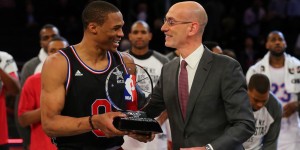
-I will open by stating that this is not a popular pick, especially with Curry and Paul coming before Russell on this list, but let’s make the claim. Westbrook’s biggest, best attribute comes from something that the above-captioned statistics do not represent: heart. Westbrook’s motor, determination, fire, intensity, and visible effort are enough to make him look completely psychotic when he’s on the floor. Earlier in his career, this was a problem, resulting in high turnover rates and selfish play. Maturity, a few small injuries, and a few deep runs into the playoffs have changed that. Westbrook is probably the second fastest guard in the league after John Wall, but he’s the strongest guard of them all and also has leaping ability that goes beyond any point guard by far. Westbrook can hover in the lane, jumping with the force that it appears that his body actually accelerates after a second of lift-off. His assist numbers climb every season, increasing up to almost nine last year, which puts him in the top section for point guards because he runs the pick and roll so well with good shooters like Durant, Serge Ibaka, and Enes Kanter. At 6-3 and with strength, speed, agility, and jumping ability, Westbrook is able to rebound like a forward, sitting in the post offensively when he’s off the ball and forcing one-on-one matchups with defenders who are slower and smaller than him. He can either elevate over them to shoot his quick and accurate midrange jumper, or, back them down and draw a double team, forcing a kick-out to an open teammate. His ball-handling is above average, as is his defense. The case could be made that Westbrook would see more selections to all-NBA defensive squads if he didn’t gamble so much. He takes risks going for steals and blocks, trying to make a big play and get out in transition. When dialed in, he can defend with the best of them because of excellent foot work and agility. He also led the league in scoring last season, the first point guard to do so since Oscar Robertson. He averages more points, assists, rebounds, and steals than Steph Curry, also has a higher PER and a higher BPM. The only category of those six that Paul has over him is assists. Westbrook’s box plus/minus, first in the league last year, shows his value added to his team. He was immensely important last season after Durant got hurt, and Westbrook was more than willing to take the team on an impressive run before falling short at the end. A wrist injury left Westbrook out for a few weeks at the beginning of the season, and we all know of Durant’s issues, so Westbrook had the Thunder digging out of a monster hole. If we expedite the winning percentage from after that early-season losing streak, the Thunder would’ve been the six seed in the West without their second and third best players in Durant and Ibaka. Last season was the coming out, and we could get more of the ‘Brodie’ this year on a Thunder team hungry for a title.
Scout: “Already, national media is talking about if the two can coexist again now that Russell Westbrook has tasted the sweet nectar of never passing the ball. Already, people are talking about how he’s going to have to take the back seat, like he’s the little brother again, and like he wasn’t the scariest player in the NBA in a half-decade last year. Already, they’re saying he’s going to have to defer to the better player, Kevin Durant. Already, they’re wondering how he’ll fit in a system now that he has a coach who doesn’t want it to be like last year, who has a plan that involves Russell Westbrook being something else again, who isn’t going to hand him the keys to the space ship and say, “Fly us into the meteorite, you crazy bastard.” Already, there’s a mountain of s**t and detritus and other entirely invented controversy for Russell Westbrook. Already, there’s stuff to piss this man off. Russell Westbrook averaged 28.9 points and 7.5 rebounds per 36 minutes in games before he received a technical last year. After he got a technical, he averaged almost six more points and 1.5 more rebounds per game. Do not piss off Russell Westbrook. Do not anger the Gods. Do not get in the way. Russell Westbrook might not just be the best player on his team this year. He might be the best player in the League. Nobody is saying it,” Ben Collins, SLAM.
There’s our list, please feel free to comment in the comments section below here on CONJ Sports, and feel free to contact Matt at the email listed in his profile.
